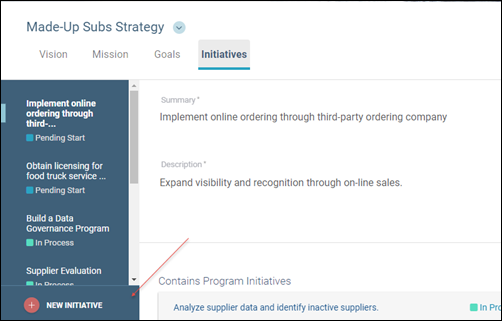Add Goals
A goal is a S.M.A.R.T. (Specific, Measurable, Achievable, Results focused and Time bound) objective that defines the moving parts of program and company objectives. Clear, measurable goals can prove that an organization’s strategy is being implemented and affecting real results. Your goals should support your overall strategy, have a timeframe, and be clearly articulated in defined business terms.
S.M.A.R.T goals make company and program objectives easier to track. When employees already know what is expected of them, managers will have an easier time administering regular check-ins with their employees. Goals ensure that the efforts being made are keeping the company or program on track. If the company or program is not on track, goals allow managers to quickly identify when course correction is needed so that teams can meet deadlines with high-quality work.
Goals can be added at the program and company levels, and program-level goals should be aligned to the company-level goals they support. Align goals with associated program and company-level Initiatives, as well.
Goals should be constructed similarly to rules, in that the goal should be system agnostic, but still detailed enough that technical users can read the goal and determine a function to calculate the thresholds for success and failure of that goal.
Define Meaningful Metrics for Goals
Most businesses today rely on high-quality information to support initiatives that improve performance and productivity. Data and information offer insights about products, services, and customers. That knowledge helps businesses innovate and grow. Metrics determine what success or failure will look like for your company and its programs. To define meaningful metrics for your goals, catalog where that metric is used (for example, in which reports) and what are the thresholds that determine success?
Fewer, more meaningful metrics are more effective at informing business decisions than a large quantity of metrics that don’t apply to goals that are currently in flight. Progress should be measured before impact, as progress must be made before the impact of that progress can be measured. Metrics help company and program leaders make informed decisions about how their efforts are paying off and give insights as to when may be a good time to pivot and change directions with a strategy.
Company Level
Having S.M.A.R.T. goals is key to the success of any organization. Goals require concrete expectations, time frames and metrics to monitor a company’s success. Clearly articulate goals in defined business. To determine if the goal has been met, define clear metrics focused on growth in revenue, cost and process optimization or regulatory compliance. Organizations focused on customer intimacy may have goals focused on improvements of process capability indexes and sigma levels of data quality. Companies focused on operational efficiency may have goals related to internal SLA compliance and process capability indices.
Program Level
Goals help program managers set and communicate clear boundaries and expectations for a program’s objectives. Goals provide program managers with a documentation structure that encourages inclusion of the important information that corporate leaders need to consider the realistic, metrics-bound objectives of the program while also formalizing the relationship that data stewards have to data-related assets in an efficient and thoughtful manner.
Goals and initiatives work together to ingrain the organization’s strategy into daily decisions and tasks. For example, if part of your Mission is to engender customer intimacy, then you may have goals that focus on increasing sigma levels of customer data quality. A “Data Quality Reporting project” initiative defines what will improve customer intimacy. The goal of increasing sigma levels of data quality defines why the corresponding Initiative engenders customer intimacy.
Concrete expectations, time frames and metrics must be defined when setting goals. If you cannot measure and monitor your goals, then you cannot know if they have been achieved. Please refer to the Identify Metrics to Support Goals section for more information.
Company Leaders Need to Know:
- What concrete improvement will the company see as a result of achieving this goal?
- How does the program goal help the company achieve its aligned company goals?
- How long will the goal take to implement?
- Who is accountable for the associated data-related assets?
Data Stewards Need to Know:
- What concrete results are expected with the implementation of the goal?
- How do the program-level goals support their aligned company goals?
- What priority should the work have? How important is it to the health of the program and the company?
- Which data-related assets are associated with the goal?
- What other teams, data stewards, and SMEs must collaborate to accomplish the goal?
By providing corporate leadership and data stewards with the information they need to understand a program’s measurable expectations, goals help build a cohesive culture dedicated to supporting and implementing that program.
Add Goals
Before you begin this task, make sure you have selected the correct context from the Company and Program strategy level drop-down on the strategy homepage.
To add Goals:
- Select the Strategy to which you are adding the Goal from the Strategy drop-down.
- Click the Goals tab.
-
Do one of the following:
- If this is the first Goal added to the Strategy, click the Click Here To Get Started link.
-
If one or more Goals have been added, click the Pencil (
 ) icon, and then click New Goal.
) icon, and then click New Goal. 
- Enter a Summary of the Goal.
- Enter a detailed Description of the Goal.
-
Enter the Success Metric for the Goal.
NOTE: The Success Metric is the benchmark metric this Goal must meet to be considered achieved.
-
Do one of the following:
-
For a program level goal, click the Select a Company Level Goal... drop-down to select a goal. Once selected, the link opens the details of the roll-up goal. This program level goal is displayed on the company level goal’s asset detail page.
-
For a company level goal, you can view the program level goals that are associated with this goal in the Contains Program Goals panel.

-
-
Select a Status for the goal from the drop-down. Values are:
- In Process - Currently being carried out
- Pending Start - Awaiting decision to begin
- At Risk - May not be achieved as described or within the timeframe set
- Abandoned - Discontinued with no further interest
- Achieved - Accomplished or brought to a successful end
- Enter a Timeframe for completing the Goal.
-
In the Related Initiatives panel, click the pencil (
 ) icon and select a related initiative from the guidance panel to add it to this goal.
) icon and select a related initiative from the guidance panel to add it to this goal.NOTE: This is a list of initiatives by which this goal is achieved.
- Click Save.
If the goal is in Review or Accepted status, and you are not a sponsor of the goal, you can be an additional endorser of the goal by clicking the Add Your Endorsement icon. Your name is added to the Additional Endorsers list.

NOTE: Alternatively, you can contest a goal. Refer to Contest an asset for more information. Refer to Sponsor an Asset for details about the asset endorsement process such as how it affects the asset’s status.
Next, you can:
- Add a Sponsor
- Share the URL for the Goal
- Add Supporting Documentation to the Goal
- Apply Categories to Assets
- Edit a Goal
To edit a Goal:
- Click the Goals tab on the strategy homepage.
- Click the Goal you want to edit.
- Click Save to save your edits.
